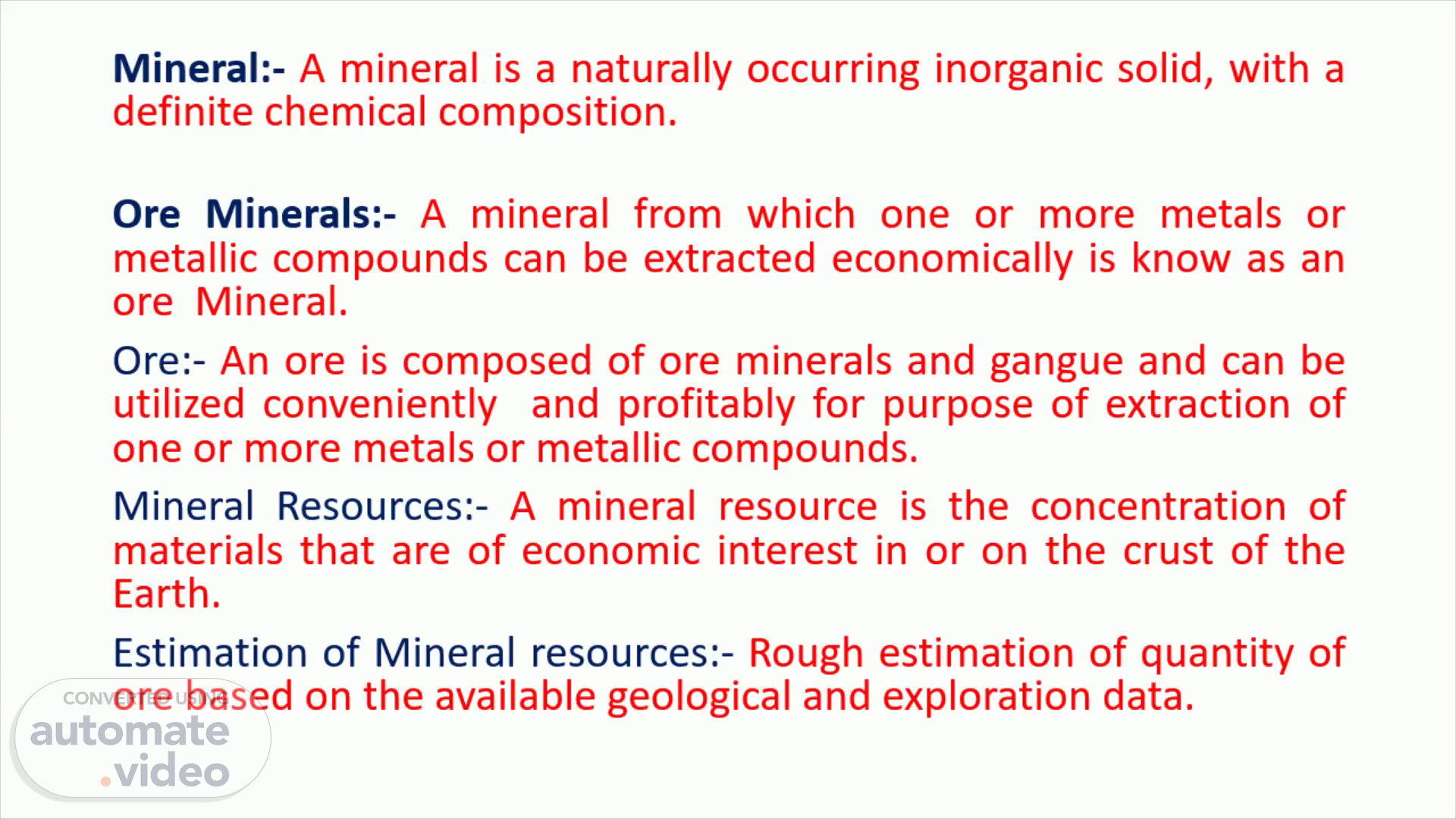
Various Methods of Reserve estimation as per UNFC
Scene 1 (0s)
Various Methods of Reserve estimation as per UNFC.
Scene 2 (1s)
Mineral:- A mineral is a naturally occurring inorganic solid, with a definite chemical composition. Ore Minerals:- A mineral from which one or more metals or metallic compounds can be extracted economically is know as an ore Mineral. Ore:- An ore is composed of ore minerals and gangue and can be utilized conveniently and profitably for purpose of extraction of one or more metals or metallic compounds. Mineral Resources:- A mineral resource is the concentration of materials that are of economic interest in or on the crust of the Earth. Estimation of Mineral resources:- Rough estimation of quantity of ore based on the available geological and exploration data..
Scene 3 (1m 5s)
Requirements for estimation of resources .. Geological Mapping. Exploration data and Chemical Analysis. Bulk density/ Tonnage factor. Recovery factor. Threshold value and Cut off grade of the ore..
Scene 4 (3m 30s)
Methods of reserve estimation.. The ore reserve estimation methods can be grouped in three ways 1 ) Geometric method (conventional method): - major types of conventional methods are as follows. a) polygon method. b) triangular method. c) cross sectional method. 2) Statistical or geostatistical method. 3) Computer application or software..
Scene 5 (6m 19s)
United Nations Framework Classification (UNFC):- Is a universally applicable System for classification of mineral reserves/resources..
Scene 6 (6m 53s)
Categories of UNFC is as follows:-. 1 2 3 Economic Axis Feasibility Axis Geological assessment E1-Economic F1-Feasibility study G1-Detailed exploration E2-Potentially Economic F2-Pre-feasibility study G2-General exploration E3 -Intrinsically economic F3- Geology study G3-Prospecting G4- Reconnaissance.
Scene 7 (7m 46s)
Definition of Stages of Exploration. Reconnaissance Survey (G4) Quantity with grade estimated mostly based on indirect evidences . Preliminary Exploration (G3) Quantity with grade estimated with low level of confidence General Exploration (G2) Quantity with grade estimated with moderate level of confidence Detailed Exploration (G1) Quantity with grade estimated with high level of confidence.
Scene 8 (10m 46s)
Definition of stages of feasibility study. Geological Study (F3) A preliminary economic evaluation of the deposit should be done based on the gathered field data and a comparison with the similar deposits already in operation. Pre-Feasibility Study (F2) A Prefeasibility Study provides a preliminary assessment of the Economic Viability of a deposit and forms the basis for justifying further investigations Feasibility Study (F1) A Feasibility Study assesses in detail the technical soundness and Economic Viability of a mining project, and serves as the basis for the investment decision and as a bankable document for project financing..
Scene 9 (12m 28s)
Definition of stages of economic viability:. Intrinsically Economic (E3) Quantities, reported in tonnes or volume with grade or quality, estimated by means of a Geological Study identified to be of intrinsic economic interest, implying that the resources identified may or may not have any immediate economic value. Potentially Economic (E2) Quantities with grade reported by means of a Prefeasibility or Feasibility Study in order of increasing accuracy, not justifying extraction under the prevailing technological, economic, environmental and other relevant conditions, realistically assumed at the time of the determination, but possibly so in the future. Economic (E1) Quantities with grade identified on the basis of a Prefeasibility or Feasibility Study in order of increasing accuracy that justify extraction under the prevailing techno-economic, socio-environmental and other relevant conditions, realistically assumed at the time of the determination. The classes defined are Proved and Probable Mineral Reserves..
Scene 10 (13m 48s)
Mineral Resources :- A mineral resource is the concentration of materials that are of economic interest in or on the crust of the Earth. Based on the level of exploration resources may be estimated in the following UNFC codes. Measured Mineral Resource (331) Indicated Mineral Resource (332) Inferred Mineral Resource (333) Reconnaissance Minéral Resource (334).
Scene 11 (14m 30s)
Reconnaissance Mineral Resource (334) :- Estimation of quantity and grade based on indirect evidences including data and information generated through a reconnaissance survey. Inferred Mineral Resource (333) :- Estimated with a low level of confidence. Indicated Mineral Resource (332) :- Estimated with a moderate level of confidence. Measured Mineral Resource (331) :- Estimated with a very high level of geological confidence..
Scene 12 (16m 6s)
Mineral Reserves:- Mineral Reserve is the economically mineable part of a Measured and/or Indicated Mineral Resource..
Scene 13 (18m 28s)
Remaining Resources:- Ore which is non-mineable due to Statutory/safety restrictions and ore which are non mineable due to uneconomical conditions are Remaining resources..
Scene 14 (19m 57s)
Requirement of safety zone incase of following conditions..
Scene 15 (21m 21s)
Estimation of remaining resources as per UNFC.. Total Mineral Resources UNFC code Measured Mineral resources (331) 211 & 221 Indicated Mineral Resource (332) 222 Inferred Mineral Resource (333) 333 Reconnaissance Mineral Resource (334) 334.
Scene 16 (22m 53s)
Table showing Reserves/resources as per UNFC.. Definition Code TOTAL RESOURCE Mineral Reserve (Required for Mining plan & scheme of mining) Economically mineable part of measured or indicated mineral resources 111 121 122 Remaining Resources Prefeasibility and Feasibility mineral resources (Part of measured/ indicated resources left out after the prefeasibility/feasibility study) 211 221 222 In-situ quantity intrinsically economic, with future economic prospect pending appropriate assessment. 331 332 333 334.
Scene 17 (22m 59s)
Presentation thank you Vector Art Stock Images | Depositphotos.